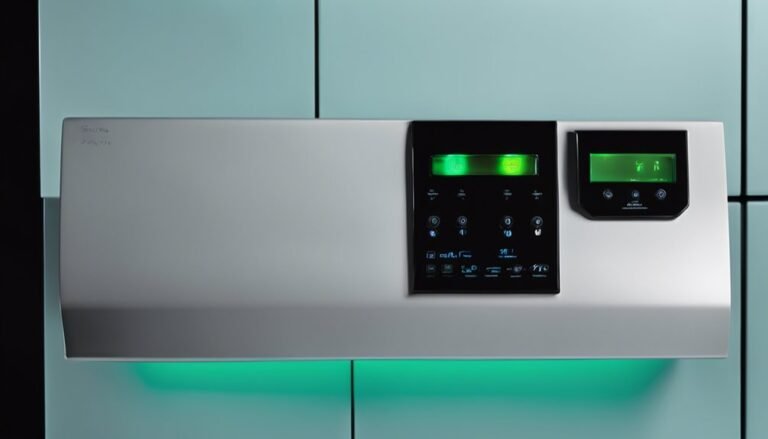Does a Water Softner Bypass While Regeneration Takes Place?
You might not realize that during the regeneration process, your water softener often relies on a bypass valve to function effectively. This clever mechanism allows unsoftened water to flow through your plumbing, ensuring you still have access to water for daily activities. However, the implications of this bypass can affect your water quality and overall system performance. Understanding how it works and when it operates can help you manage your water usage better and maintain your softener's efficiency. What specific factors should you consider during this process?
Key Takeaways
- During regeneration, a water softener can utilize a bypass valve to divert water away from the softening process.
- Bypass valves come in manual and automatic forms, providing flexibility during regeneration cycles.
- Bypassing allows for uninterrupted water supply while the softener cleans and replenishes resin beads.
- It is useful for ensuring unsoftened water is available for specific tasks during regeneration.
- Proper management of the bypass function helps maintain water quality and efficiency of the softener.
Understanding Water Softener Basics
Water softeners play an essential role in improving the quality of your water by removing hard minerals like calcium and magnesium. These minerals contribute to water hardness, which can cause various issues in your home, such as scale buildup in pipes and appliances.
To combat this, you can explore different softening methods, which primarily include ion exchange, salt-free systems, and reverse osmosis.
In the ion exchange process, hard water passes through a resin bed coated with sodium ions. As the hard minerals encounter the resin, they swap places with the sodium ions, effectively softening the water.
Salt-free systems, on the other hand, utilize a different technique that alters the structure of hardness minerals, preventing them from forming scale. This method doesn't remove the minerals but makes them less problematic.
Finally, reverse osmosis filters out impurities, including hard minerals, by pushing water through a semi-permeable membrane.
Understanding these basic concepts helps you make informed decisions about which water softening method suits your needs best. By knowing the fundamentals, you can greatly enhance your water quality and protect your home from the adverse effects of hard water.
The Regeneration Process Explained
A significant aspect of maintaining your water softener's efficiency is the regeneration process. This process guarantees that your system effectively removes hardness minerals, such as calcium and magnesium, through a method called ion exchange. During ion exchange, your water softener replaces these hard minerals with sodium ions, making your water softer.
Regeneration frequency plays an important role in how well your softener performs. Typically, the unit regenerates based on water usage or a set schedule, depending on the model.
During regeneration, the system flushes out the accumulated minerals and replenishes the resin beads with sodium. This cycle can take several hours, depending on the softener size and settings.
While the softener is regenerating, it's important to understand that your water supply will temporarily contain higher levels of sodium. Most models will bypass water softening during this phase, but knowing how and when your unit regenerates can help you plan your water usage effectively.
Bypass Valve Functionality
A bypass valve plays an important role in your water softener system.
It allows you to temporarily divert water away from the softening process, which can be useful during maintenance or when you need unsoftened water for specific tasks.
Understanding how this valve works can help you manage your water quality more effectively.
Purpose of Bypass Valve
Sometimes, you might find yourself in need of a temporary solution for your water softener system, and that's where the bypass valve comes into play. This valve is vital when you want to bypass the water softening process without turning off your entire system. It allows you to channel water directly to your home, effectively bypassing the softener's treatment.
Bypass mechanisms offer flexibility, especially during maintenance or when regenerating your water softener. Different valve types, such as manual and automatic, serve this purpose effectively. A manual bypass valve requires you to physically turn a knob or lever, while an automatic valve uses sensors to switch between soft and hard water as needed.
Using the bypass valve helps protect your plumbing and appliances from potential issues like over-saturation of softened water, especially if you need untreated water for certain tasks.
It also guarantees that you have a continuous water supply, even when your softener is busy regenerating. Understanding the purpose and function of the bypass valve can improve your water quality management, making it an essential component of your water softening system.
Regeneration Process Overview
While your water softener undergoes regeneration, understanding how the bypass valve functions is vital to maintaining a consistent water supply. The bypass valve allows water to flow around the resin tank, guaranteeing you still have access to softened water during the regeneration process. This is critical, especially when the regeneration timing occurs during peak water usage hours.
Here's a brief overview of the bypass functionality:
| Bypass Mode | Effects on Water Supply |
|---|---|
| Active | Water flows through the bypass, providing unsoftened water. |
| Inactive | Water flows through the resin tank, delivering softened water. |
| During Regeneration | The valve switches to active mode to maintain supply. |
When considering efficiency, you should plan your regeneration timing strategically. Schedule it during off-peak hours to minimize inconvenience. By understanding the bypass valve's role and making smart efficiency considerations, you can guarantee your household water needs are always met, even during regeneration.
Impact on Water Quality
When your water softener regenerates, it goes through a process that can greatly impact the quality of your water.
You'll notice changes in taste, smell, and even the clarity of the water as the system flushes out impurities.
Understanding this process is essential for ensuring you maintain the best possible water quality in your home.
Regeneration Process Explained
The regeneration process of a water softener considerably enhances water quality by effectively removing hardness minerals like calcium and magnesium. During this process, the softener uses a brine solution to flush out these unwanted minerals, restoring its ability to soften water efficiently. The regeneration duration typically takes around 30 to 90 minutes, depending on your system's design and capacity.
Here's a quick look at how the regeneration process works:
| Step | Description |
|---|---|
| 1. Backwash | The softener tank is flushed with water to remove debris and sediment. |
| 2. Brine Draw | Brine solution is drawn into the tank to exchange hardness ions with sodium. |
| 3. Rinse | The system is rinsed to wash away excess brine and prepare for service. |
Water Quality Changes
After a water softener undergoes regeneration, you'll notice significant improvements in water quality. The process effectively reduces water hardness by eliminating excess minerals like calcium and magnesium that cause unwanted buildup.
With softer water, you'll enjoy not only better-tasting drinking water but also enhanced performance for your appliances and plumbing.
When mineral buildup is minimized, you'll find that your faucets and showerheads experience less scaling, which can lead to longer-lasting fixtures.
Furthermore, your laundry will feel softer, and your soaps and detergents will work more efficiently, resulting in cleaner clothes and fewer residues. You may also notice that your skin feels softer after bathing, thanks to the absence of harsh minerals.
Moreover, regular regeneration helps maintain peak performance of your water softener, ensuring that you continue to reap these benefits over time.
If you neglect this process, you could face increased water hardness again, leading to more mineral buildup and diminished water quality.
As a result, keeping up with regeneration is essential for maintaining the quality and longevity of both your water system and your home.
Managing Water Usage
Effective management of water usage is essential for optimizing the performance of your water softener. By adopting strategic practices, you can enhance efficiency and contribute to water conservation.
Here are some useful tips to help you manage your water usage effectively:
- Schedule Regeneration Wisely: Set your water softener to regenerate during off-peak hours. This reduces the impact on your daily water needs and aligns with sustainable practices.
- Monitor Water Usage: Keep track of your daily water consumption. Recognizing patterns can help you identify areas for improvement and implement water conservation techniques.
- Fix Leaks Promptly: A small leak can waste a significant amount of water. Regularly check pipes and fixtures for leaks and repair them immediately to conserve water.
- Use Water-Saving Fixtures: Install low-flow showerheads and faucets. These fixtures not only save water but also help maintain the efficiency of your water softener.
Signs of Regeneration Cycle
Many homeowners may notice certain signs that indicate their water softener is in the regeneration cycle. Understanding these regeneration signs can help you manage your water usage effectively.
One common sign is a change in water pressure; you might feel a slight drop when the system is regenerating. You might also notice a salty taste in your water, which can occur if the softener has just completed a cycle.
Another indication is the timing of your water softener's operation. Most systems regenerate during off-peak hours, typically at night. If you hear a humming noise or feel vibrations from the unit, it's likely in the regeneration phase.
Furthermore, keep an eye on the softener's salt level. If it's low and you've recently noticed these signs, it may be time for a regeneration cycle.
Monitoring regeneration is essential to ensuring your water softener functions effectively. By being aware of these signs, you can better anticipate when your system is working hard to keep your water soft and free of hardness minerals.
Familiarizing yourself with these indicators can help maintain your water quality and overall system efficiency.
Alternatives to Bypass Options
When your water softener needs maintenance, bypass valves often provide a temporary solution, but there are several effective alternatives you can consider.
Exploring these alternative solutions not only helps maintain your water quality but also guarantees your softener works efficiently.
- Manual Regeneration: Instead of relying on a bypass, you can manually regenerate your system during off-peak hours to minimize disruption.
- Dual Tank Systems: These systems allow one tank to regenerate while the other supplies softened water. This means you won't have to bypass at all.
- Portable Water Softeners: If you're in a pinch, using a portable softener can provide softened water while your main unit is offline.
- Regular Maintenance: Staying on top of softener maintenance can prevent the need for a bypass.
Regularly checking salt levels and cleaning the resin bed ensures peak performance.
Tips for Optimal Performance
To get the most out of your water softener, it's crucial to implement a few key practices.
First, regularly check the salt levels in your brine tank. Keeping it filled to the recommended level guarantees peak performance during regeneration cycles. If you notice any salt bridges, break them up to prevent clogs.
Second, consider scheduling routine maintenance. This includes cleaning the resin tank and examining the control valve for any leaks or malfunctions. These maintenance tips not only enhance performance enhancement but also extend the lifespan of your unit.
Additionally, monitor your water usage patterns. If you have a sudden increase in demand, like during the summer months, adjust your softener's settings accordingly. This guarantees your system can handle the extra load without compromising effectiveness.
Lastly, use the right type of salt for your system. Different softeners perform better with specific salts, so consult your manufacturer's guidelines.
Frequently Asked Questions
Can I Manually Initiate Regeneration During Peak Water Usage?
You can manually initiate regeneration during peak usage, but it's not ideal. Doing so may disrupt your water supply, affecting daily activities. Consider scheduling regeneration during off-peak times for a smoother experience.
How Long Does the Regeneration Process Typically Take?
The regeneration duration usually takes about two hours. During this time, your softener efficiency may fluctuate, so it's best to schedule regeneration during off-peak hours to minimize any impact on your water usage.
Will My Water Bill Increase During Regeneration Cycles?
You might notice an increase in your water bill during regeneration cycles, as water usage temporarily rises. However, the impact on your overall billing will depend on your household's typical consumption and the frequency of regeneration.
Can Regeneration Affect the Lifespan of Plumbing Fixtures?
Regeneration can impact plumbing longevity if not managed properly. You should guarantee regular fixture maintenance to prevent mineral buildup. This keeps your plumbing efficient and extends the lifespan of your fixtures while maintaining water quality.
Is It Safe to Drink Water During the Regeneration Process?
Imagine sipping water from a fountain of youth—during regeneration, it's best to avoid drinking it. Health concerns arise, as water quality may temporarily dip, so wait for the process to finish before quenching your thirst.
Conclusion
So, while your water softener's busy playing a game of hide and seek with the minerals, you can still enjoy uninterrupted access to water thanks to the trusty bypass valve. It's ironic, isn't it? You've got a machine working hard to keep your water soft, yet it guarantees you won't even notice the drama unfolding inside. Embrace the convenience, and remember, a little patience during regeneration goes a long way in maintaining your water quality.







